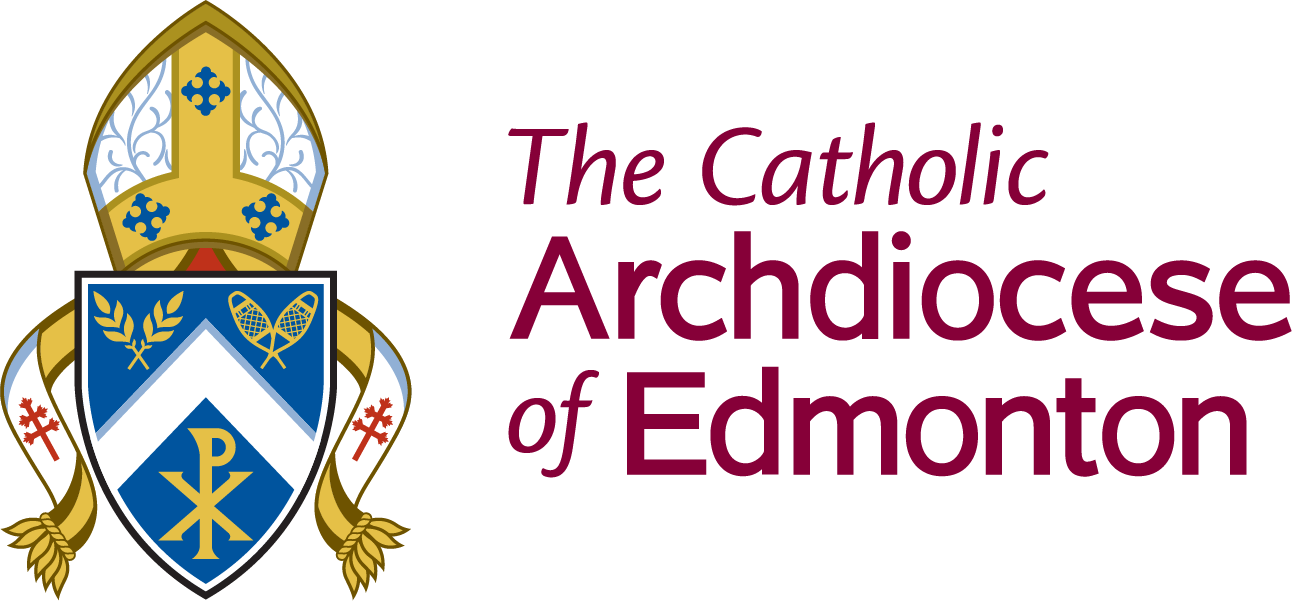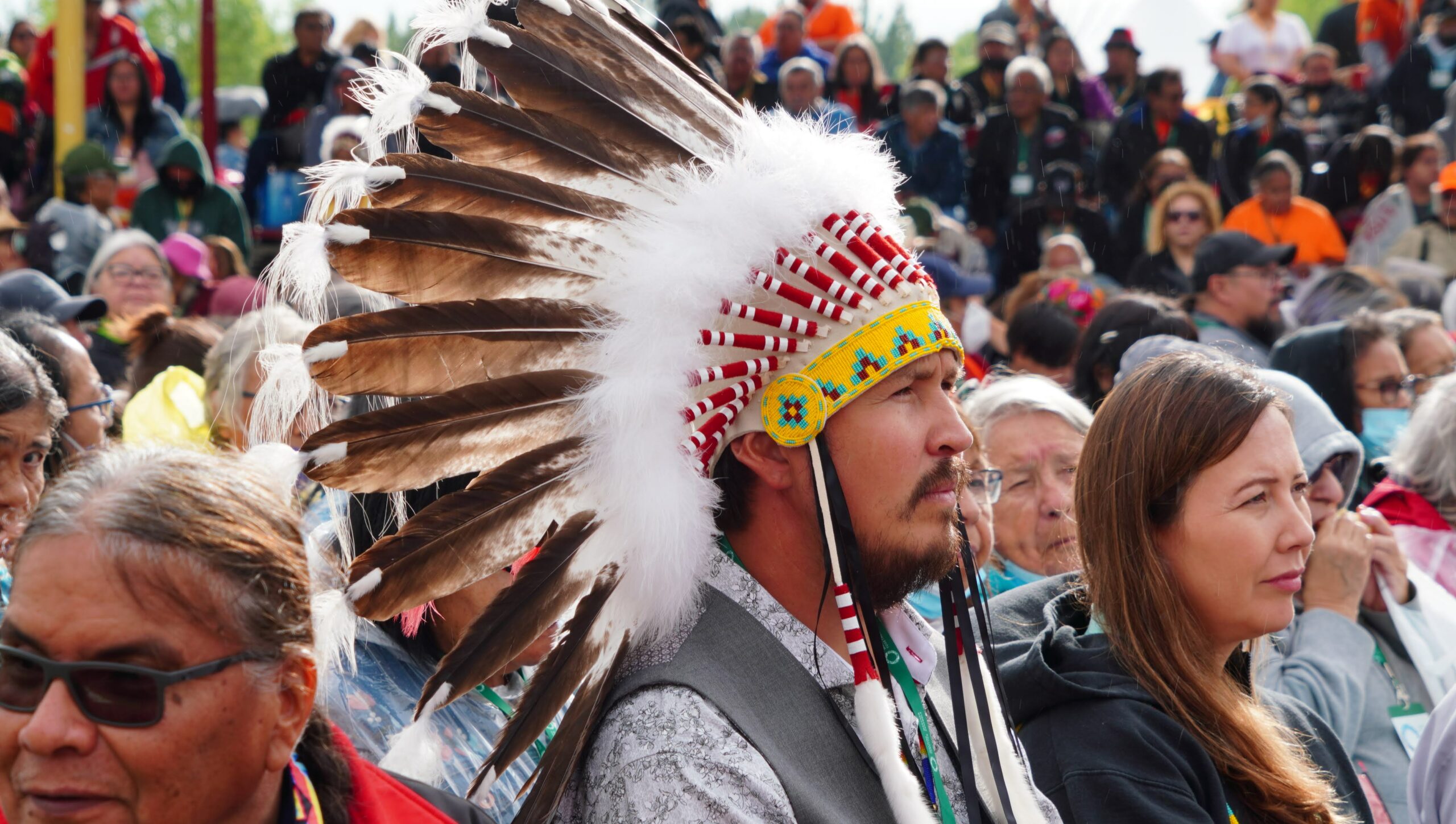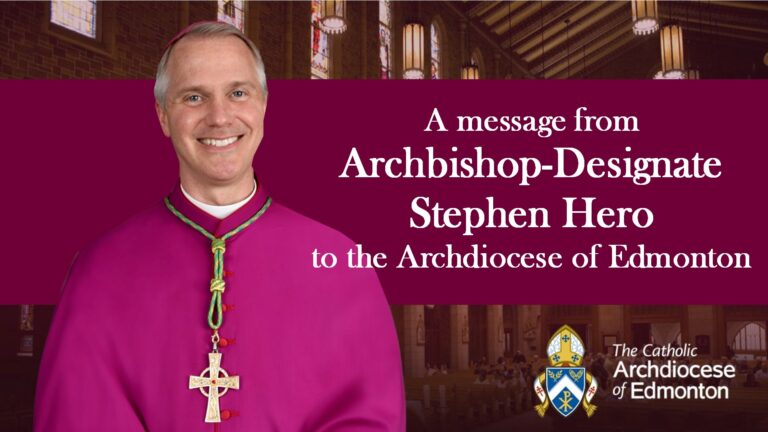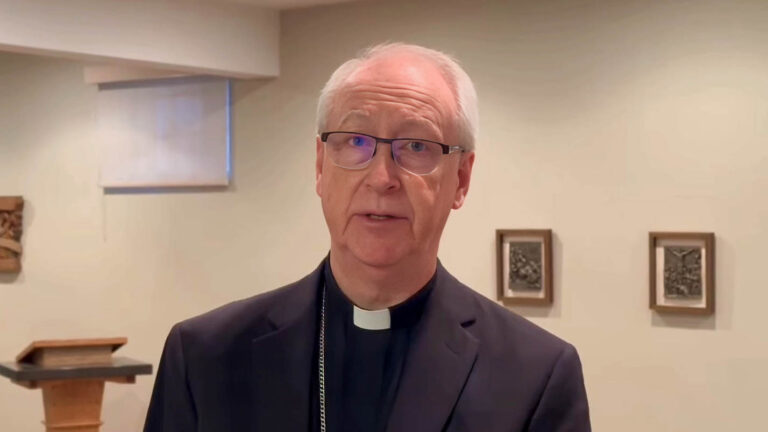Red Deer Catholic School District Faith Day
Bringing the Papal Visit Home
Introduction
Thank you very much for the invitation to join you all on this faith formation day. It has been a while since a visit to the school district has been possible, so I’m glad to be here. In particular, I am really pleased to be able to spend some time with the whole district, all in one place: the community of teachers, administrators, and trustees. Our parish priests are also present; their presence, together with me, signals our partnership and our desire to strengthen it for the sake of the students entrusted to our care.
I understand we have a half hour for these thoughts I’ve put together for our time together. I salute your wisdom. It is a very wise thing to place a time limit on me. No doubt my brother priests wish they could find a way to do the same.
Before I launch into the presentation proper, let me say a word of heartfelt thanks to you. Catholic education is a vitally important ministry within the life and mission of the Church. It brings together two great treasures of the Church: the children and her doctrine. We can offer no greater gift to the children than to share with them the joy and hope that spring from the Gospel of Jesus Christ. To many of the students, you in Catholic education are the face of the Church; this places upon you the beautiful and challenging responsibility to lead the students to Jesus Christ, a task that requires coherent witness of word and life. I and my brother priests stand always ready to support you in your calling. Please know I, and we, are deeply grateful for all you do to fulfill it.
Today I have gathered my thoughts together under the title, “Bringing the Papal Visit Home.” Allow me to assure you that I have not enlisted the assistance of ChatGPT. Had I done so you would likely be receiving a far more intelligent presentation than what I have prepared on the basis of my limited human intelligence. What I mean by the title is this: while we are all aware how the papal journey unfolded when the Pope fulfilled his promise to visit the home of the Indigenous Peoples, it remains for us to bring that experience home to ourselves. We are gathered for a day of formation in the faith, in which context we can ask what the papal visit can teach us about our own development as disciples of Jesus Christ. The apostolic journey of the Holy Father was clearly a pivotal moment in the history of our country. If we reflect upon some of its aspects and bring them home, I believe it can be a pivotal moment in the personal histories of each one of us also. Pope Francis labelled his visit a penitential pilgrimage, center on reconciliation. This faith formation day occurs in the penitential season of Lent, inherent in which is the call to each of us to be reconciled with God. All of this is to say that I will develop these reflections on the papal visit around our own need for reconciliation and suggest some pathways for our own penitential pilgrimage back to Jesus Christ. I will take my lead from three distinct moments before, during, and after the papal visit.
The Pathway of Listening in Order to Hear
This pathway emerged in what I call the “prelude” to the papal visit. By this term I mean the delegation of Indigenous Peoples who visited with Pope Francis at the Vatican in late March of last year. I consider it a great blessing and privilege that I was one of a few Bishops who accompanied the group. Even though by that time the Holy Father had already indicated his intention to visit Canada at an undetermined time, nevertheless it can be understood as a prelude precisely because of the listening that occurred within it. It was during those days that the Pope confirmed to the Indigenous delegates that he would visit them where they live, and at that moment expressed his hope that he could do so around the time that they gave honour to Sainte Anne, the grandmother or kokum of Jesus.
So, what was this listening that happened? In the course of less than one week, Pope Francis dedicated five hours to the delegates. We can imagine how extraordinary this is in the context of the gruelling calendar of the Pope. In fact, people I spoke to in the Vatican told me that the dedication of this amount of time to one delegation was unprecedented. It unfolded this way: each group within the delegation – First Nations, Métis, and Inuit, were given their own audiences with Pope Francis, who received them in his office in the Apostolic Palace. I was present for every encounter. During each of the meetings, the Pope simply listened, but by this I do not mean that he was in any way passive. He listened in order to hear. Story after story, pain upon pain, and hope after hope, was shared with him. It was clear to all that he was listening deeply – at the level of the heart. As I witnessed what was taking place, it was clear that heart was speaking to heart – the hearts of the Indigenous Peoples were laid bare, and what they had to say reached the heart of the Pope. And we all knew it. In fact, reflecting later upon the event, one of the Indigenous leaders said, “he really heard us!” The Pope said nothing other than a few summary words at the end of each session; his final address was reserved to the end of the week. And that final address was clearly not one that had been prepared weeks in advance, as often happens with anticipated papal speeches. It was a reflection upon what he had heard in the days immediately prior. The Pope had listened in order to hear, which is to say, he allowed himself to be impacted by what was shared with him, or to put in as he did in his final address, he allowed himself to imagine himself in their place so as to try to experience within himself the pain and trauma so evident in the delegates’ testimonies.
Now, what does it mean for us to bring this home? Well, I suggest that, just as listening in order to hear was the decisive impetus for the Pope’s penitential pilgrimage, so too must listening in order to hear be understood as the first step in our own Lenten journey of penance. Yet right away we encounter a massive challenge, one which I am sure you have already identified. In our culture we tend not to listen in this way. In fact, sometimes it seems we have lost the ability to listen at all, unless it is to my own desires and wants. Listening to the other, in our rather fractured society, assumes the form not of listening in order to hear but listening in order to respond, or more accurately, listening in order to shut down whatever opinions or positions challenge my own. This phenomenon often goes by the name of cancel culture, which can thrive even in academic environments. We also have the phenomenon of creating “safe spaces” where I can be shielded from ideas that might be offensive or hurtful. The first step, then, in the penitential return to the Lord is to do a self-assessment of my stance vis-à-vis listening; do I listen to hear or listen to shut down; am I one who listens at all?
Then, to whom am I called to listen? For our specific purposes today, I highlight the one interlocutor who matters, the one message that must be engaged seriously and deeply if we are to grow in faith: God’s self-revelation in Jesus Christ. Do I listen to Jesus in order to hear, that is, open to be challenged and transformed?
Let me linger here a moment on the term “Revelation”. Before Christianity is a religion, it is a revelation, or, to put it more accurately, a response to Revelation. Our Christian faith arises from the astounding and wondrous fact that God has spoken to His people. He has done so in order to reveal Himself to the world. In fact, we can go further and say that, since Jesus Christ is God’s Word made flesh, God has spoken in order to give Himself to His people. By Revelation we mean God’s own self-gift to us, offered in love that we might respond in love in the mutual bond we call covenant. Since the initiative always belongs to God, our stance is that of listening, the first act, each day, of the true disciple. The prophet Isaiah underscored this with his prayer, the words of which lead me to suggest it as particularly suited to people involved in Catholic education: “The Lord God has given me the tongue of a teacher, that I may know how to sustain the weary with a word. Morning by morning he wakens—wakens my ear to listen as those who are taught.” (Isaiah 50:4) Clearly, what is understood here is a listening in order to hear, in order to be impacted and directed.
The question for ourselves, then, is: how do I listen to Revelation? What God has to say has been recorded in the inspired Sacred Scriptures, which have as their centre the life, death and resurrection of Jesus Christ, who is in himself God’s perfect and unsurpassable self-revelation, the one to whom the voice of the Heavenly Father has said we must listen. This Revelation is handed on in the Church in what we call Tradition, especially the doctrine of the Church. What is my reaction when I encounter in this divine Revelation something I do not like, something that challenges me to change? That I shall is not surprising. The first words that Jesus addressed to his hearers were repent, change your life! Listening to hear will be manifest in an attitude of humility before God and a readiness to be changed. Listening in order to respond or react will express itself in a replacement of God’s Word with my own reasoning, a choice of myself as my own moral compass, or even in reactions that attempt to have the Church change her teaching to be more in accord with “the times”, with so-called “progress”.
If we are tending toward the latter, it is perhaps helpful to return to what happened in the Apostolic Palace, namely, the encounter in which heart spoke to heart. This is what Revelation is: God revealing his own heart and addressing it to our own. God’s every Word is reflective of a love for us that is great beyond imagination. God will never deceive us, never lead us astray. He will always speak to us what is for our good. His Word, then, is fully worthy of our trust. So, let’s ask for the grace for transformed hearts. Listening in order to react or shut down is what the Bible would call a hardened heart. Let’s listen with the heart in order to hear and thus be well launched along our own penitential pilgrimage.
The Pathway of Determination
h to follow arose from the prelude to the papal visit. The second comes from the visit itself. I call it the “pathway of determination.”
While he was in Quebec, Pope Francis celebrated mass at the Basilica of Ste Anne-de-Beaupré. The church was packed, and about ninety per cent of the participants were Indigenous Peoples. I was seated in the sanctuary with a good view of the congregation. At the end of mass and before leaving the sanctuary, the Pope took time to bless a statue. While this was happening, the crowd surged forward to get near the Pope and people packed together so tightly in the main aisle and at the entrance to the sanctuary that we had to give up any idea of a liturgical procession out of the church. Vatican security and the Swiss guards were arranged in a tight circle around the perimeter of the sanctuary to control access. From where I was seated, I noticed some movement in the main aisle about half way toward the back of the church. It was caused by a young Indigenous woman with a child. It seemed to me that she was trying to make her way toward the sanctuary, and I thought to myself there is no way that she will be able to get through the crowd or anywhere near the Pope. How wrong I was. I don’t know how she did it but she made her way to the front, and when I could see her more clearly, I could understand why she was so determined and would let no circumstance stand in her way. In her arms was an infant with very obvious and serious birth defects. With all the worries, hopes and dreams that mother was carrying in her heart for her child – as would any mother – she was determined to have her baby blessed by Pope Francis. When she reached the sanctuary, she made known her wish to a security guard, he looked back to his commander, and the commander did not hesitate to direct that she be allowed in with the baby. The next thing we knew the child was in the arms of the Holy Father being blessed and kissed by him, with the mother standing proudly and hopefully at their side.
As I think back on that, it occurs to me that what we all witnessed that moment was the meeting of two determined people. The determined woman and her child encountered the Pope, who himself demonstrated his own remarkable determination to come to Canada precisely for encounters such as that. It is well known that, prior to coming to Canada, the Pope’s health was significantly impaired by serious mobility issues. A number of planned trips were being cancelled, one after the other. That left us wondering if he would make it at all, and I must say I was personally astonished when it was announced that he would, in fact, be coming to Canada. My astonishment and admiration deepened as I spent time in his company during the papal visit. He was in constant pain, and had to limit his events to one in the morning and another in the evening, with lots of rest in between. Yet, it is clear that the Pope was utterly determined to come to Canada. He had listened to testimonies of pain and wanted to draw near. He had promised to come and nothing would keep him from fulfilling that promise.
I want to emphasize also that the spirit of determination pervaded the entire experience. Throughout the visit, I was deeply edified by the determination of almost 4000 volunteers across the country to make the penitential pilgrimage of the Holy Father a success for everyone. This extended as well to our partners in the Indigenous community and the government at all levels. Everyone was determined that this would be what we all hoped it would be and needed it to be. Moreover, someone else was determined, and more than all of us put together: and that is the Lord God, our Creator and Redeemer. His grace and accompaniment led and accompanied everyone at every step.
How do we bring this lesson home? We do so by asking ourselves how determined we are to be reconciled with God and one another. In the gift of Jesus Christ, especially in his dying and rising, we have on full and clear display just how determined God is to save us from sin and its lethal effects. Having heard the cries of His suffering people, and having promised to send a Saviour, God was determined to visit us in the person of His Son. And Jesus himself, of course, was fully determined to fulfill the mission he had received from the Father, one that even took him to the Cross. Are we determined to go to Christ and encounter the gift of his love and mercy? There can reside within us a strange lethargy and complacency. We know from our readings of Sacred Scripture and from the promptings of our conscience when something is just not right in our lives, when there are unrepented sins or circumstances inconsistent with my identity as a Christian, yet rather than seek out the encounter with Christ and have him change our situations, we don’t move. Unlike the young Indigenous woman, we don’t challenge the pressure of the crowd that would keep us where we are. The journey to reconciliation often involves praying that the Lord awaken us out of our sleepwalking and arouse within us a new determination to put things right. The meeting in the sanctuary at Ste Anne de Beaupré stands as a symbol of the encounter God wants to have with each one of us, one where determination meets determination, and the human heart is open to receive that greatest of blessings we call divine mercy.
The Pathway of Healing
The third and last pathway was impressed upon me as I heard post-visit of its impact on the lives of people, specifically their stories of healing.
There is the story told by a woman who had participated in the event at Maskwacis and mass at Commonwealth Stadium. She spoke of having been consumed by anger during a good portion of her life. This was a woman who had every reason to be angry. Her mother had been a student at a residential school, and the experience was not a good one. Later in life her mother got into drugs and ended up dying on the streets. The burden of anger weighed heavily upon her daughter for many years. She recounted how, following the mass, and having reflected upon the words of the Holy Father, in a moment all of that anger lifted from her and was gone. It was an experience of deep healing, one that set her free.
A few months ago, I spent an evening with the parish pastoral council at Sacred Heart Church of the First Peoples, one of the venues visited by the Holy Father during his time in Alberta. I wanted to check in to see how they were doing. That parish had worked very hard and with great intensity to welcome the Pope and share with him the story of their life together as a community of disciples. It was a great opportunity to reminisce about the visit, their meeting with the Pope, and what it meant for them. As they took turns around the table to share with me recollections and their impact, it was not long before the tears began to flow. Person after person spoke of healing, either that which had occurred within themselves or in the hearts of their family members. Common to all the stories was the sentiment of profound gratitude that the Pope had come and made this possible for them. A while after that I spoke to one of the parish Elders, a woman who met the Pope and told me he had actually patted her cheek. Some people with me at the time asked if she had washed her face since. She not only said that she hadn’t but also that she was hoping to get the police to brush her face for the Pope’s fingerprints as a lasting reminder!
How to bring this home? Whenever I have come across such stories of healing, whether before, during, or after the papal visit, I have found myself wondering about my own need for healing. In one way or another, we all experience brokenness. What are we doing about it? As a people of Christian faith, we acknowledge Jesus as the great healer, the divine physician. It is clear to us that the healings that happened because of the papal visit were the workings of divine grace. He brought about wonderful transformations in the lives of people who were even just a little open to receive his healing grace. He wants to do the same for each of us. Many Indigenous peoples have shown great courage in naming their pain and exposing their wounds. This act of naming need is the first necessary step on the pathway of real healing. Yet I fear we are sometimes not even courageous within our own selves and prefer to bury hurts rather than name them, even to ourselves. Yet, do we want to stay there, or do we want genuine healing? Let’s not be afraid to name our brokenness and bring it to Christ, asking him to do what he alone can, so that we, too, can know the joy and freedom that comes from deep healing.
Conclusion
To conclude, I stay with Sacred Heart Church and refer to the address that the Holy Father delivered there during his encounter with the parishioners. His knowledge of the many good works accomplished in that parish there by Indigenous and non-Indigenous people together led him to reflect upon the mystery of the Church.
Looking to the Cross of Jesus he said this: “Jesus, through the four extremities of his cross, has embraced the four cardinal points and has brought together the most distant peoples; Jesus has brought healing and peace to all things (cf. Eph 2:14). On the cross, he accomplished God’s plan: ‘to reconcile all things’ (cf. Col 1:20).” This act of reconciliation by Jesus brought together those who believe in him into one body, his Body, the Church. From this the Holy Father concludes with the beautiful description of the Church as “the living body of reconciliation,” and then expressed this wish: “In every crucified person whom we meet, may we see not a problem to be solved, but a brother or sister to be loved, the flesh of Christ to be loved. May the Church, the Body of Christ, be a living body of reconciliation!”
May that be our prayer for this Red Deer Catholic School District. You all understand well that Catholic education is a part of the mystery of the Church and thus participates in her mission. Let us “bring home” to our awareness and to our every action in our schools the call for this district to be a “living body of reconciliation”. That means, to begin, that we embrace the truth that we are, each of us, on a pilgrimage of reconciliation. That journey means listening to hear; it requires determination; it rejoices in the gift of healing; and it recognizes that every one of us is on the same path. From this recognition will arise a readiness to be patient with one other and on the lookout to offer support and strength to each other whenever needed. Above all it means acknowledging that we do not walk alone, neither individually nor communally, but that Jesus walks with us. We cannot be the living body of reconciliation, we cannot truly walk the journey together, as your theme proposes, without having our gaze fixed constantly on the reconciling Cross, the perfect sign of the love that heals and brings people back together.
Most Reverend Richard W. Smith
Saint Joseph High School
March 10th, 2023



